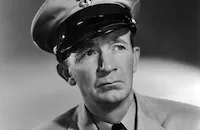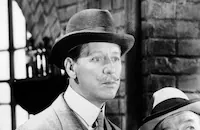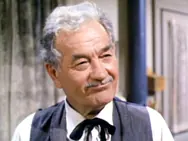The Green Promise

Brief Synopsis
Cast & Crew
William D. Russell
Marguerite Chapman
Walter Brennan
Robert Paige
Natalie Wood
Ted Donaldson
Film Details
Technical Specs

Synopsis
As Papa Matthews and his four motherless children drive with real estate agent Julius Larkins to inspect a farm for possible purchase, their truck breaks down on the road. The stranded family is helped by passing David Barkley, the county agricultural agent, who takes an immediate liking to Deborah, the eldest Matthews daughter. Although Deborah has reservations about the farm, Papa Matthews is keen to buy and, during one of his "democratic" family votes, pressures his children to agree with him. After they have settled in, the financially strapped Papa announces that the three younger children, Phineas, Abigail and Susan, must miss a school term in order to help plant crops. Deborah insists that the children attend school, however, in accordance with their dead mother's wishes, and Papa reluctantly agrees. Later, Susan, the youngest child, meets neighbors Jessie Wexford and her brother Buzz, who proudly shows off "Caesar," a prize Angus steer he has raised as part of his project for the local 4-H Club, a national organization designed to prepare children to be successful farmers. That night, Deborah tells Papa that David has suggested that they plant potatoes, but Papa, whose previous farming venture was a failure, insists on planting soy, a crop with which he has experience. During a family meeting, Susan, having been inspired by Buzz's profit-making 4-H project, eagerly asks Papa for money with which to buy two lambs. Papa calls Susan's request selfish and then forces Phineas to vote with him and Abigail against her. Susan is crushed by her father's scornful attitude and seeks comfort in Deborah, her only reliable ally. Deborah, meanwhile, tries to help David convince Papa not to cut down their hillside timber, which David knows is needed to prevent flooding during heavy rainstorms. The mulish Papa, however, refuses to take David's admonitions seriously and continues cutting timber, which he plans to sell in order to pay for a tractor. As part of a recruiting effort, David then takes Susan to visit various 4-H projects. Susan is deeply impressed by the 4-H Club, whose clover-leaf emblem stands for head, heart, hand and health, but becomes upset and withdrawn when she recalls her father's angry words. Later, after he is turned down for a date, David accuses Deborah of being a coward where her father is concerned, and she angrily orders him to leave. At church the next Sunday, Reverend Jim Benton lectures about the sin of ignorant pride, but, much to Deborah's dismay, Papa sleeps through the entire sermon. Soon after, however, Papa becomes bedridden when he is badly injured cutting trees, and Deborah is forced to take over the farm's operation. Acting on David's advice, Deborah halts the timber cutting without consulting Papa. Tattle-tale Abigail, however, relays the information to her father, and he not only denounces Deborah, but secretly orders the cutting resumed. Susan, meanwhile, joins the 4-H Club and, with David's help, secures a small loan from the local bank with which to buy two lambs. Later, Susan and Phineas attend a 4-H costume party at Buzz's house. When a vicious storm blows in, Susan becomes concerned about her lambs, which she has left in a shed, and slips away from the party. David helps the rain-soaked Susan bring her lambs inside, then rescues Deborah, who is vainly struggling to prevent the hillside from collapsing. The next morning, with the crops destroyed by flood water, Papa finally admits to his family that his fear of failure and loneliness drove him to make unwise decisions. He then asks for their forgiveness, saying that their understanding will give him the courage to continue. After they happily reunite, the Matthews then look out their window to see their neighbors driving up, eager to help restore their battered farm.

Director
William D. Russell
Cast

Marguerite Chapman

Walter Brennan

Robert Paige

Natalie Wood
Ted Donaldson

Connie Marshall
Robert Ellis
Jeanne La Duke

Irving Bacon

Milburn Stone

Geraldine Wall
Crew
David Chudnow
Roscoe Cline
Monty F. Collins
Monty F. Collins
Richard Farrell
William Fox
Mary Gibsone
Tad Gillum
Henry Mack
Gus Morin
Martin Obzina
Robert Paige
Vera Peterson
Joe Popkin
John L. Russell
Rudy Schrager
Ed Tetzoldt
Jack Voglin

Photo Collections
Videos
Movie Clip





Hosted Intro
Film Details
Technical Specs

Articles
The Green Promise
Unseen for years due to copyright restrictions, The Green Promise (1949) was the result of a collaboration between a wealthy Texas oilman from Houston, Glenn McCarthy, actor Robert Paige, a leading man of B movies, and Monty Collins, a screenwriter and former gag writer for silent two-reeler comedies. McCarthy wanted to break into movies as a producer of "wholesome entertainment" and Paige and Collins had a script (penned by Collins) that combined family values along with an endorsement for 4-H clubs. McCarthy knew that his friend, Howard Hughes, was interested in distributing family entertainment through his studio RKO and pitched him the project. The Green Promise was given the green light and William D. Russell, a friend of Collins, was brought on to direct the film and Paige claimed a key role for himself.
The rest of the casting was a more elaborate affair and started with Diana Lynn who was chosen to play Deborah. Then she broke her arm after ten days of shooting and had to be replaced by Marguerite Chapman. Prior to this, an extensive national talent hunt was conducted at 4-H clubs around the country with one of the finalists, ten-year-old Jessie La Duke from Mt. Vernon, Indiana, winning the supporting role of Jessie Wexford after a successful screen test in Hollywood. Walter Brennan, a three time Oscar® winner as Best Supporting Actor was given the role of the grouchy, mean-spirited father and fifteen-year old actors Connie Marshall and Ted Donaldson, were assigned parts as the two middle children, Abigail and Phineas, respectively. The big casting coup, however, was young Natalie Wood, a popular child actress who had stolen moviegoers' hearts with her charming performance in Miracle on 34th Street (1947) two years earlier. Wood was under contract to 20th-Century-Fox at the time but was loaned out to RKO for the movie.
The Green Promise was filmed around the Feather River in California, near Sacramento, with additional scenes shot on the Monogram Studios lot. Initially budgeted at a modest cost with a short shooting schedule, the film ended up going over budget and deadline due to the replacement of Diana Lynn. On the set, Natalie Wood was given the star treatment and co-star Chapman observed that Natalie's over-protective mother, "was with her constantly. There wasn't any interaction personally, not at all. The moment she finished a scene, she was gone." She also noted that Natalie "had this little pet Chihuahua and it ate at the dining table, and that was a bit off-putting to some of us. They'd put it up and it would be licking stuff off the plate."
While The Green Promise was more of a showcase for Natalie Wood than any other cast member and gave her plenty of dramatic moments, including numerous crying scenes, co-star Ted Donaldson felt she preferred the quieter moments of the film such as the scene where she tenderly caresses her pet lambs. "That's probably the freest, most open, most Natalie expressing who she was, at those moments," he recalled. "I remember a certain kind of glow, and giving over to the moment with them. That was a very genuine thing." Of course, Natalie's big moment in the film is the climactic thunderstorm scene in which she races to rescue her pet lambs and is almost swept off a bridge into raging waters below. The bridge scene, which was filmed the last week of production, didn't proceed as expected. According to Suzanne Finstad's biography Natasha: The Biography of Natalie Wood, the dangerous stunt almost ended tragically. "When I was halfway across," Natalie said later, "somebody pulled the lever prematurely and I was thrown into the water." She managed to catch hold of the collapsing bridge, clinging to the edge as the current pulled her in the direction of the waterfall. "My mother leaped forward crying, my child!" Natalie later told a reporter, "and the director said, 'Keep the cameras rolling! Keep the mother back!' Natalie's left wrist was broken and she nearly drowned. "I don't even remember them fishing me out." "It was so traumatic for her," observes her later confidant, Marc Crowley. "She'd been lied to, for one thing. And then there she was, fearful of her life." At the moment the accident occurred, the camera captured the expression of sheer terror on Natalie's face and that shot remains in the finished film. The incident was kept a secret from the press and Natalie's mother didn't threaten the producers with a lawsuit because she believed if you sued a studio, you were blacklisted in the industry and would never work again. Still, the incident left Wood with a pathological fear of water that would haunt her the rest of her life.
The Green Promise had its world premiere at the annual 4-H Congress in Chicago on December 2, 1948. Producer McCarthy also held a premiere in his hometown of Houston at the Shamrock Hotel which was attended by numerous celebrities who traveled from Hollywood for the event on McCarthy's private train; among them were Robert Stack, Dorothy Lamour, Sonja Henie, Robert Ryan, Van Heflin and Pat O'Brien. The film's reception by critics and moviegoers was decidedly less spectacular with The New York Times review typical of the general consensus: "The Green Promise...represents a fair sampling of tall, green cinematic corn...The few bright spots in the picture are generated by the animated interest of youngsters as they turn their energies to fruitful domestic and social pursuits through various 4-H club enterprises. The scenery is clean and refreshing, too, as most of the picture unfolds in farming country enclosed by lush timberland. Natalie Wood, youngest of the smallfry thespians, is a fetching little lass with a look that is full of poignant appeal."
While The Green Promise was not a hit for RKO and sent Glenn McCarthy back to his oilwells, abandoning any future plans as a film producer, it was a personal triumph for Natalie Wood whose performance was singled out by most critics. She would continue her reign as a child star for several more years before transitioning into young adult roles in 1955 with such films as Rebel Without a Cause and One Desire.
Producers: Monty F. Collins, Robert Paige
Director: William D. Russell
Screenplay: Monty F. Collins
Cinematography: John L. Russell
Art Direction: Martin Obzina
Music: Rudy Schrager
Film Editing: Richard Farrell
Cast: Marguerite Chapman (Deborah Matthews), Walter Brennan (Mr. Matthews), Robert Paige (David Barkley), Natalie Wood (Susan Anastasia Matthews), Ted Donaldson (Phineas Matthews), Connie Marshall (Abigail Matthews), Robert Ellis (Peter 'Buzz' Wexford), Jeanne LaDuke (Jessie Wexford), Irving Bacon (Julius Larkins), Milburn Stone (Rev. Jim Benton), Geraldine Wall (Mrs. Wexford).
BW-93m.
by Jeff Stafford
SOURCES:
Natalie Wood: A Life by Gavin Lambert
Natasha: The Biography of Natalie Wood by Suzanne Finstad
www.afi.com
IMDB

The Green Promise
Quotes
Trivia
There is one scene where a young Natalie Wood is supposed to run across a bridge. She was told that the bridge would collapse after she got to the other side, but there was an accident and the bridge collapsed while she was still on it. She broke her hand and it never healed properly. She always wore a bracelet to hide the lump left behind.
Notes
The Green Promise was the first film to be made by Glenn McCarthy Productions, a company formed specifically for this picture by wealthy Texas oilman Glenn McCarthy, and was the first independent project selected for production under Howard Hughes's new RKO regime. According to a Los Angeles Daily News news item, McCarthy, who was an acquaintance of Hughes, agreed to finance the picture because he felt there was a dearth of family entertainment in Hollywood. McCarthy made a deal with producers Robert Paige and Monty F. Collins in which they would receive fifty per cent of the film's profits, and he, forty-nine per cent. Contemporary news items add the following information about the production: Diana Lynn was first cast as "Deborah Matthews," but was replaced by Marguerite Chapman because of a broken arm. Jeanne La Duke, a ten-year-old 4-H Club member from Mt. Vernon, IN, was chosen to play "Jessie Wexford" after an extensive talent search at 4-H Clubs around the country. La Duke was one of four 4-H Club girls who were selected as "finalists" and were tested in Hollywood. Virginia Lee was announced as a cast member in Hollywood Reporter, but her appearance in the final film has not been confirmed. Some scenes in the film were shot in Feather River country in northeast California.
The Green Promise had its world premiere on December 2, 1948, during the annual 4-H Club Congress in Chicago, IL. According to Hollywood Reporter, McCarthy held a premiere in his hometown of Houston, Texas, in conjuction with the opening of his Shamrock Hotel, which was an $18,000,000 venture. More than forty "movie personalities" rode McCarthy's "Shamrock Special" train from Hollywood to Houston for the opening, which included a five-mile "torchlight parade of the stars," according to Hollywood Reporter. The top ticket price at the Houston opening was $4.65. Although Hollywood Reporter announced in December 1948 that McCarthy was planning a sequel to The Green Promise, entitled A Road to the Stars, about the "home demonstration agents of the Department of Agriculture," no evidence that the picture was ever made has been found. A Hollywood Reporter news item notes that distribution of the picture was taken over by Beverly Pictures in November 1953.















